PHYSICAL SCIENCES PHYSICS PAPER 1 GRADE 12 QUESTIONS - NSC PAST PAPERS AND MEMOS JUNE 2016
Share via Whatsapp Join our WhatsApp Group Join our Telegram GroupPhysical Sciences P1
Grade 12
June 2016
NSC Past Papers And Memos
INSTRUCTIONS AND INFORMATION
- This paper consists of EIGHT questions. Answer ALL the questions
- Number the answers correctly according to the numbering system used in this question paper.
- Leave one line between two sub-questions, for example between QUESTION2.1 and QUESTION 2.2.
- You may use a non-programmable calculator.
- You may use appropriate mathematical instruments
- Show ALL formulae and substitutions in ALL calculations.
- Round off your final numerical answers to a minimum of TWO decimal placeswhere necessary.
- Give brief motivations, discussions, et cetera where required
- Write neatly and legibly.
QUESTIONS
QUESTION 1: MULTIPLE-CHOICE QUESTIONS
Four options are provided as possible answers to the following questions. Each question has only ONE correct answer. Choose the answer and write only the letter(A - D) next to the question number (1.1 - 1.10)..
1.1 Which one of the following represents a scalar quantity?
- Work of -10 J
- An acceleration of 10 m·s-2
- A force with a magnitude of 10 N
- Velocity with a magnitude of 10 m·s-1 (2)
1.2 An object X, mass m, is moving at constant velocity v along a smooth,horizontal surface. An identical object Y is dropped onto object X and stays there. Which one of the following represents the velocity of the combination X + Y?
- Zero
- ½v
- v
- 2v (2)
1.3 A rock is dropped from a tall building. Which one of the following combinations correctly describes the acceleration and velocity of the rock while it is falling? Ignore the effect of air resistance.
| Accelaration | Velocity | |
| A | Increases | Increases |
| B | Constant | Constant |
| C | Constant | Increases |
| D | Zero | Constant |
(2)
1.4 Three separate, identical blocks are in contact with each other in a straight line. They are at rest on a smooth, horizontal surface. Each of these blocks has a mass m. Another block with the same dimensions, but with mass 2m,moving at a velocity v, collides ELASTICALLY and in the same straight line with the three stationary blocks.
Which one of the following diagrams represents the situation immediately after the collision?


 (2)
(2)
1.5 A girl is standing on the surface of the earth and drops a ball. After the first second of its motion it has a displacement y. A similar experiment is done on the surface of the moon. What would the displacement during the first second be if the gravitational acceleration on the moon is 1/6 of that of the earth?
Ignore the effects of friction.
- 1/6y
- 1/3y
- 3/5y
- 5/6y (2)
1.6 A car, moving at a constant velocity with kinetic energy K, undergoes a displacement x in time t. If the car's kinetic energy changes to 2K, it will undergo a displacement of .......in the same time at the new constant velocity.
- 4x
- 2x
- √2 x
- 1/√2 x (2)
1.7 In the circuit represented below, the internal resistance of the battery is negligible.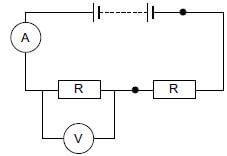
Which one of the following combinations correctly represents the changes in the reading on the voltmeter and the ammeter when a copper wire is used to connect the two black dots? (2)
| Voltmeter reading | Ammeter reading | |
| Increases | Increases | |
| Increases | Decreases | |
| Decreases | Decreases | |
| Decreases | Increases |
1.8 Two blocks, P and Q, manufactured from the SAME MATERIAL (coefficient of kinetic friction is μ in both cases) and with masses of 2m and m respectively,are placed on the hypotenuse of a triangular wooden block as shown below.The distance between the blocks is x. The heavier block (P) is above Q. When they are released SIMULTANEOUSLY, they move down the inclined plane at increasing velocity.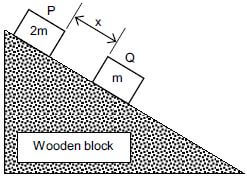
How is the distance x affected while the two blocks move?
- Increases.
- Decreases.
- Remains the same.
- It is not possible to tell from the available information. (2)
1.9 A ball is dropped from rest. Ignore air friction. Which one of the following graphs best represents the relationship between:
each of kinetic energy (K),gravitational potential energy (U) and mechanical energy (M) as functions of the displacement of the ball? (2)
1.10 Three electric charges, each with magnitude Q, are kept stationary in thesame plane at three corners (X, Y and Z) of a rectangle. The long and short sides of the rectangle have lengths of 2r and r respectively.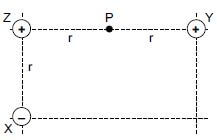
The NET ELECTROSTATIC force on the charge at Z, due to the other TWO charges, is equal to F.
The charge at Y is then MOVED and placed at P, and the charge at X is REPLACED by another negative charge with a different magnitude. What should the magnitude of the NEW charge at X be to keep the MAGNITUDE ofthe NET ELECTROSTATIC force on the charge at Z the same as before?
- 4Q
- 2Q
- Q
- Q (2)
[20]
QUESTION 2
A block of mass 4 kg is connected to another block of mass 2 kg by a light,inextensible string. The system is pulled up a rough plane, inclined at 30° to the horizontal, by means of a constant force of 73,8 N parallel to the plane, as shown inthe diagram below.
The magnitude of the kinetic frictional force on the 4 kg block is 20 N. The coefficientof kinetic friction applicable to the 2 kg block is 0,589.
2.1 Define the concept frictional force. (2)
2.2 State Newton's second law of motion in words. (3)
2.3 Draw a free-body diagram, with labels, showing ALL the forces acting on the 4 kg block as it moves up the incline. Please be mindful of the following:
- You may not include components of forces in your diagram.
- You may not use numbers as labels. (5)
2.4 Calculate the magnitude of the kinetic frictional force on the 2 kg block. (4)
2.5 Calculate the tension in the string that connects the two blocks. (6)
2.6 The system is pulled up the rough incline once more, but this time the twoblocks are swapped as indicated below. How will this influence each of thefollowing? Choose your answer from DECREASES, REMAINS THE SAMEor INCREASES.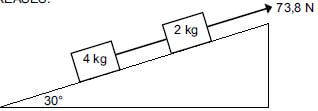
2.6.1 The acceleration of the 2 kg block (2)
2.6.2 The force of friction on the 4 kg block (2)
2.6.3 The tension in the string (2)
[26]
QUESTION 3
A stationary rocket on the ground is launched vertically upwards. After 4 s, the rocket's fuel is used up when it is 225,6 m above the ground (Point R). At this instant the velocity of the rocket is 112,8 m·s-1. The rocket reaches its MAXIMUM heightABOVE ground at point S. Ignore the effects of air friction. Assume that g does not change during the entire motion of the rocket.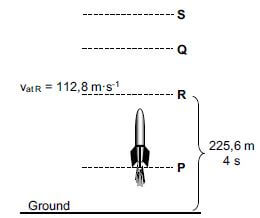
3.1 Draw a free-body diagram, with labels, of the forces acting on the rocket at point P. The lengths of your arrows should represent the comparative magnitudes of the forces. (3)
3.2 What is the direction of the acceleration of the rocket at:
3.2.1 point P; and (1)
3.2.2 point Q? (1)
3.3 At which point (P or Q) is the rocket in free fall? Give a reason for theanswer. (2)
3.4 Take UPWARD MOTION as POSITIVE and use ONLY EQUATIONS OF MOTION to calculate the following:
3.4.1 The magnitude of the acceleration of the rocket between theground and point R (3)
3.4.2 The time it takes from the moment the rocket is launched until itstrikes the ground again (6)
3.5 Take UPWARD AS POSITIVE and sketch a velocity-time graph for the motionof the rocket from the moment it is launched (at t = 0 s) until it strikes theground.
Indicate the following values on the graph:
- Velocity of the rocket on the ground
- Velocity of the rocket at each of points R and S
- Time at point R; and
- Time at which the rocket strikes the ground. (6)
[22]
QUESTION 4
Percy, mass 75 kg, rides at 20 m.s-1 on a quad bike (motorcycle with four wheels) with a mass of 100 kg. He suddenly applies the brakes when he approaches a red traffic light on a wet and slippery road. The wheels of the quad bike lock and the bike slides forward in a straight line. The force of friction causes the bike to stop in 8 s.
4.1 Define the concept momentum in words. (2)
4.2 Calculate the change in momentum of Percy and the bike, from themoment the brakes lock until the bike comes to a stop. (4)
4.3 Calculate the average frictional force exerted by the road on the wheels tostop the bike. (4)
4.4 Write down the work-energy theorem in words. (2)
4.5 Calculate the work done by the frictional force to stop the bike. (3)
[15]
QUESTION 5
A block of wood, mass 1,595 kg, is placed on the edge of a table 1,5 m above thefloor.The block is struck by a bullet, mass 0,005 kg, moving at an UNKNOWN horizontal velocity. After the impact, the bullet is embedded in the block, which falls tothe floor. The block strikes the floor with a speed of 5,6 m.s-1. Ignore all types of friction.
5.1 State the principle of conservation of mechanical energy in words. (2)
5.2 Use the principle of conservation of mechanical energy to calculate themagnitude of the velocity with which the block leaves the table. (5)
5.3 State the principle of conservation of momentum in words. (2)
5.4 Calculate the magnitude of the velocity with which the bullet strikes theblock. (4)
[13]
QUESTION 6
The speed of sound in air depends among others on the air temperature. The following graph shows this relationship.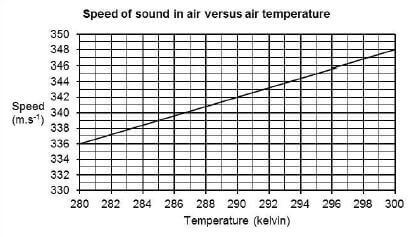
6.1 Which one of temperature or speed is the dependent variable? (1)
6.2 The gradient of this graph is equal to 0,6 m·s-1·K-1. With how much does the speed, in m·s-1, increase for every 5 K increase in temperature? (1)
6.3 Two experiments are done to verify the Doppler Effect. In the first experiment, an object approaches a stationary observer X at a constant speedof 57,5 m·s-1. The object is equipped with a siren that emits sound waves at afixed frequency of 1 000 Hz. The motion takes place in still air at a temperature of 295 K.
6.3.1 Describe what the Doppler Effect is. (2)
6.3.2 What is the speed of sound, in m·s-1, in air at 295 K?HINT: Use the graph (1)
6.3.3 Calculate the frequency measured by observer X. (4)
6.3.4 In the second experiment, the object moves away from observer X at the same constant speed as before. What should the air temperature, in kelvin, be to make it a fair test between the two experiments? (1)
6.4 Consider the three diagrams below. Each one represents the source (with the siren) and observer X. Two of the diagrams are applicable on the above mentioned experiments.
6.4.1 Which diagram is applicable to experiment 2? (1)
6.4.2 Which diagram is NOT applicable to any of the experiments?Give a reason for your answer. (2)
[13]
QUESTION 7
7.1 A small metal sphere X, on an insulated stand, carries a charge +2 nC.nC.
7.1.1 What is an electric field? (2)
7.1.2 Draw the electric field pattern associated with X. (2)
7.1.3 Calculate the magnitude of the electric field at any point 1 m from the centre of X. (3)
7.2 An identical sphere Y, which carries a charge of -7nC, is used to touch X.The two spheres are afterwards placed 2 m apart as shown below.
7.2.1 In which direction did the electrons flow while X and Y were incontact? Write down X TO Y or Y TO X. (1)
7.2.2 Calculate the charge on X after the separation. (3)
7.2.3 State Coulomb's law in words. (3)
7.2.4 Calculate the electrostatic force that is exerted on X due to the presence of Y. (5)
[19]
QUESTION 8
A satellite orbiting at a height h above the earth's surface. the height h is 5% of the earth's radius.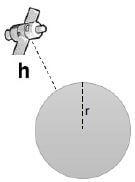
8.1 State Newton's Law of Universal Gravitation in words (2)
8.2 Calculate the value of g at the height above the earth's surface (5)
8.3 How would the value of g in QUESTION 8.2 above change if the value of h is decreased? Write down INCREASE, DECREASE or REMAIN THE SAME (1)
8.4 With what factor would the gravitational force of attraction between the satellite and the earth change if the distance between theri centres is halved? Justify your answer. (3)
[11]
QUESTION 9
A design engineer in charge of the crash worthiness of new automobiles models conducts experiments by smashing them into fixed massive barriers at 50 km.h-1.A new model of a car of mass 1 500 kg takes 0,15 s from the time of impact until it is brought to rest.
9.1 Define the term impulse. (2)
9.2 Calculate the impulse of the car. (5)
9.3 Calculate the average force exerted by the barrier on the car. (4)
[11]
TOTAL: 150